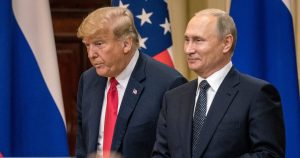On August 8, 2025, U.S. President Donald Trump announced a historic Trump-Putin meeting scheduled for August 15, 2025, in Alaska, aimed at addressing Russia’s ongoing war in Ukraine. This announcement followed Trump’s ultimatum to Russian President Vladimir Putin, demanding a ceasefire by August 8 or face severe secondary sanctions on countries trading with Russia.
The Trump-Putin Meeting: Background of the Ukraine War and Trump’s Ultimatum
The war in Ukraine, initiated by Russia’s full-scale invasion in February 2022, has resulted in tens of thousands of deaths and significant territorial losses for Ukraine, including Crimea and parts of Donetsk, Luhansk, Kherson, and Zaporizhzhia.
The conflict has strained U.S.-Russia relations, with the Biden administration imposing sanctions and providing extensive military aid to Ukraine.
Upon taking office in January 2025, Trump vowed to end the war swiftly, leveraging his personal rapport with Putin. The Trump-Putin meeting stems from this pledge, following months of escalating pressure on Russia.
In mid-July 2025, Trump issued a 50-day ultimatum for Russia to cease hostilities, later shortened to 10 days due to his frustration with Putin’s lack of progress.
On July 31, the U.S. informed the UN Security Council that August 8 was the final deadline for Russia to engage in meaningful negotiations, threatening tariffs on nations like India and China for purchasing Russian oil.
The Trump-Putin meeting, announced on the day the deadline expired, signals a shift from threats to direct diplomacy, though uncertainty remains about whether sanctions will proceed. you can read more about this topic here.
The Trump-Putin Meeting: Context and Objectives
The Trump-Putin meeting, set for August 15 in Alaska, marks the first U.S.-Russia summit since 2021, when then-President Joe Biden met Putin in Geneva.
Alaska’s selection as the venue is strategic, given its proximity to Russia across the Bering Strait and the U.S.’s non-membership in the International Criminal Court (ICC), which has issued an arrest warrant for Putin over alleged war crimes.
The Trump-Putin meeting aims to negotiate a ceasefire, with Trump suggesting “swapping of territories” as a potential solution, a proposal that has sparked controversy among Ukrainian and European leaders.
Trump’s objectives for the Trump-Putin meeting include securing a ceasefire to fulfill his campaign promise of ending the war quickly.
He has expressed frustration with Putin’s continued attacks on Ukrainian cities, describing them as “disgusting” and signaling a tougher stance.
However, the Kremlin has proposed a ceasefire that involves Ukraine ceding significant territories, including the Donbas region, and halting Western military aid.
This proposal, which Trump has partially endorsed by discussing territorial swaps, has raised concerns about Ukraine’s sovereignty and the exclusion of Ukrainian President Volodymyr Zelenskyy from the Trump-Putin meeting.
Geopolitical Implications of the Trump-Putin Meeting
The Trump-Putin meeting carries profound implications for the Ukraine war and global geopolitics. For Ukraine, the absence of Zelenskyy from the summit has fueled fears of a deal being imposed without Kyiv’s input, reminiscent of the 1945 Yalta Conference where great powers decided Europe’s fate.
Zelenskyy has firmly rejected territorial concessions, citing Ukraine’s constitution, which requires a referendum for any territorial changes. He warned that any agreement excluding Ukraine would be a “dead solution” that rewards Russia’s aggression.
European allies, also absent from the Trump-Putin meeting, are wary of Trump’s approach, which appears to prioritize bilateral U.S.-Russia negotiations over multilateral frameworks.
Analysts warn that conceding territory to Russia could embolden Putin’s expansionist ambitions, potentially threatening NATO’s eastern flank.
The Institute for the Study of War has argued that Putin remains uninterested in genuine peace, using negotiations to extract concessions while maintaining Russia’s long-term goal of controlling Ukraine.
For the U.S., the Trump-Putin meeting is a high-stakes gamble. Trump’s decision to host Putin on U.S. soil, breaking from expectations of a neutral venue, signals confidence in his deal-making abilities but risks legitimizing Putin, who has been isolated by Western sanctions.
The meeting also reflects Trump’s broader “America First” policy, which seeks to reduce U.S. involvement in prolonged conflicts while asserting dominance in global diplomacy.
However, his willingness to consider territorial swaps has strained relations with Ukraine and Europe, potentially undermining NATO unity.
Potential Outcomes of the Trump-Putin Meeting
The Trump-Putin meeting could yield several outcomes, each with significant consequences:
- Ceasefire with Territorial Concessions: Russia’s reported proposal involves Ukraine ceding Donbas and other occupied regions, with international recognition of Russian control. Trump’s openness to “swapping territories” suggests he may entertain this idea, though it would face fierce opposition from Ukraine and its allies. Such a deal could temporarily halt fighting but risks rewarding Russia’s aggression and weakening Ukraine’s sovereignty.
- Stalemate and Escalation: If the Trump-Putin meeting fails to produce an agreement, Trump may follow through on his threat of secondary sanctions, targeting countries like India, which recently faced a 50% tariff hike for Russian oil imports. This could escalate economic tensions, disrupt global energy markets, and provoke retaliatory measures from Russia, such as increased attacks on Ukraine or cyberattacks on Western infrastructure.
- Multilateral Engagement: Experts like Thomas Graham of the Council on Foreign Relations suggest that a constructive outcome would involve charting a path toward an enduring ceasefire, followed by broader negotiations including Ukraine and European allies. This approach would require Trump to balance his bilateral strategy with multilateral commitments, ensuring Ukraine’s voice is heard.
- Strengthened U.S.-Russia Dialogue: The Trump-Putin meeting could open channels for broader U.S.-Russia discussions on issues like strategic stability, the Middle East, and Arctic policy. However, this risks alienating allies if perceived as prioritizing U.S.-Russia relations over Ukraine’s interests.
Challenges and Risks
The Trump-Putin meeting faces several challenges. Putin’s insistence on Ukraine relinquishing occupied territories and abandoning NATO aspirations clashes with Zelenskyy’s non-negotiable stance on territorial integrity.
The exclusion of Ukraine and European allies from the Trump-Putin meeting has drawn comparisons to great power diplomacy that sidelines smaller nations, potentially undermining trust in U.S. leadership.
Moreover, Trump’s mercurial approach—oscillating between praising Putin and threatening sanctions—creates uncertainty about his commitment to a coherent strategy.
Posts on X reflect skepticism about Trump’s ultimatums, with some analysts arguing that secondary sanctions are unlikely to force Russia to end the war without significantly increased military support for Ukraine.
Russia’s continued battlefield advances, particularly in Donetsk, and Putin’s confidence in Russia’s economic resilience further complicate negotiations.
The choice of Alaska, while logistically practical, carries symbolic weight. Russia’s historical claim to Alaska, sold to the U.S.
in 1867, has been invoked by Russian nationalists, and hosting Putin there could be seen as a provocative gesture.
Additionally, Trump’s decision to move nuclear submarines in response to Russian rhetoric, as noted after comments by Dmitry Medvedev, risks escalating tensions.
Broader Geopolitical Context
The Trump-Putin meeting occurs amidst other regional developments, notably the Armenia-Azerbaijan peace agreement signed on August 8, 2025, at the White House, which Trump also facilitated.
This success has bolstered Trump’s confidence in his deal-making capabilities, but the Ukraine conflict is far more complex, involving great power rivalries and NATO’s strategic interests.
Russia’s recent diplomatic engagements with China, South Africa, and Central Asian states suggest Putin is rallying allies to counter U.S. pressure, potentially complicating the Trump-Putin meeting’s outcome.
Iran, a key player in the Middle East, also watches the Trump-Putin meeting closely, as it could influence U.S.-Russia dynamics in regions like the South Caucasus, where Iran opposes initiatives like the Zangezur Corridor.
A U.S.-Russia deal that strengthens Russia’s position could embolden Iran’s adversaries, such as Israel and Azerbaijan, further complicating Middle Eastern dynamics.
A Pivotal Moment for Peace or Escalation
The Trump-Putin meeting on August 15, 2025, in Alaska represents a critical juncture in the Ukraine war and U.S.-Russia relations.
Trump’s ultimatum to Russia, backed by threats of sanctions, has set the stage for high-stakes diplomacy, but the exclusion of Ukraine and European allies risks undermining a durable peace.
The Trump-Putin meeting could lead to a temporary ceasefire, but any deal involving territorial concessions would face significant resistance from Kyiv and its supporters.
As the world watches this historic summit, the outcome will shape not only the Ukraine conflict but also the broader geopolitical landscape, testing Trump’s ability to balance his deal-making instincts with the complexities of international diplomacy.
SOURCE: raialkhalij


